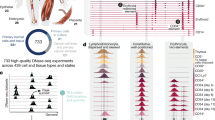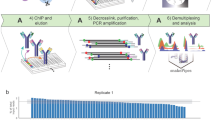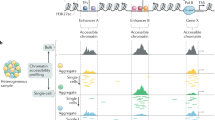Abstract
Mapping DNase I hypersensitive sites is an accurate method of identifying the location of gene regulatory elements, including promoters, enhancers, silencers and locus control regions. Although Southern blots are the traditional method of identifying DNase I hypersensitive sites, the conventional manual method is not readily scalable to studying large chromosomal regions, much less the entire genome. Here we describe DNase-chip, an approach that can rapidly identify DNase I hypersensitive sites for any region of interest, or potentially for the entire genome, by using tiled microarrays. We used DNase-chip to identify DNase I hypersensitive sites accurately from a representative 1% of the human genome in both primary and immortalized cell types. We found that although most DNase I hypersensitive sites were present in both cell types studied, some of them were cell-type specific. This method can be applied globally or in a targeted fashion to any tissue from any species with a sequenced genome.
This is a preview of subscription content, access via your institution
Access options
Subscribe to this journal
Receive 12 print issues and online access
$259.00 per year
only $21.58 per issue
Buy this article
- Purchase on Springer Link
- Instant access to full article PDF
Prices may be subject to local taxes which are calculated during checkout






Similar content being viewed by others
Accession codes
References
The Encode Consortium. The ENCODE (ENCyclopedia Of DNA Elements) Project. Science 306, 636–640 (2004).
Wu, C. The 5′ ends of Drosophila heat shock genes in chromatin are hypersensitive to DNase I. Nature 286, 854–860 (1980).
Gross, D.S. & Garrard, W.T. Nuclease hypersensitive sites in chromatin. Annu. Rev. Biochem. 57, 159–197 (1988).
Wu, C., Wong, Y.C. & Elgin, S.C. The chromatin structure of specific genes: II. Disruption of chromatin structure during gene activity. Cell 16, 807–814 (1979).
Crawford, G.E. et al. Identifying gene regulatory elements by genome-wide recovery of DNase hypersensitive sites. Proc. Natl. Acad. Sci. USA 101, 992–997 (2004).
Dorschner, M.O. et al. High-throughput localization of functional elements by quantitative chromatin profiling. Nat. Methods 1, 219–225 (2004).
Sabo, P.J. et al. Discovery of functional noncoding elements by digital analysis of chromatin structure. Proc. Natl. Acad. Sci. USA 101, 16837–16842 (2004).
Crawford, G.E. et al. Genome-wide mapping of DNase hypersensitive sites using massively parallel signature sequencing (MPSS). Genome Res. 16, 123–131 (2006).
Ren, B. et al. E2F integrates cell cycle progression with DNA repair, replication and G(2)/M checkpoints. Genes Dev. 16, 245–256 (2002).
Scacheri, P.C. et al. Genome-wide analysis of menin binding provides insights to MEN1 tumorigenesis. PLoS Genet. 2, 406–419 (2006).
Scacheri, P.C., Crawford, G.E. & Davis, S. Statistics for ChIP-chip and DNase hypersensitivity experiments on NimbleGen arrays. Methods Enzymol. (in the press).
McArthur, M., Gerum, S. & Stamatoyannopoulos, G. Quantification of DNase I-sensitivity by real-time PCR: quantitative analysis of DNase I-hypersensitivity of the mouse beta-globin LCR. J. Mol. Biol. 313, 27–34 (2001).
Kim, T.H. et al. A high-resolution map of active promoters in the human genome. Nature 436, 876–880 (2005).
Jantzen, K., Fritton, H.P. & Igo-Kemenes, T. The DNase I sensitive domain of the chicken lysozyme gene spans 24 kb. Nucleic Acids Res. 14, 6085–6099 (1986).
Acknowledgements
We thank E. Margulies and the Multiple Species Alignment group from the ENCODE consortium for kindly providing the sequence conservation track. We also thank S. Anderson, A. Elkahloun, and the National Human Genome Research Institute Microarray core for excellent technical assistance. This research was supported by the Intramural Research Program of the US National Human Genome Research Institute, National Institutes of Health.
Author information
Authors and Affiliations
Corresponding author
Ethics declarations
Competing interests
R.G. is employed by NimbleGen Systems.
Supplementary information
Supplementary Fig. 1
Control to rule out sequence bias of DNaseI enzyme. (PDF 368 kb)
Supplementary Table 1
Positive predictive value (PPV) of DNase-chip as assessed by real-time (RT) PCR. (DOC 43 kb)
Supplementary Protocol
DNase-chip protocol. (DOC 31 kb)
Rights and permissions
About this article
Cite this article
Crawford, G., Davis, S., Scacheri, P. et al. DNase-chip: a high-resolution method to identify DNase I hypersensitive sites using tiled microarrays. Nat Methods 3, 503–509 (2006). https://doi.org/10.1038/nmeth888
Received:
Accepted:
Published:
Issue Date:
DOI: https://doi.org/10.1038/nmeth888
This article is cited by
-
Chromatin accessibility and the regulatory epigenome
Nature Reviews Genetics (2019)
-
Venous identity requires BMP signalling through ALK3
Nature Communications (2019)
-
Initial high-resolution microscopic mapping of active and inactive regulatory sequences proves non-random 3D arrangements in chromatin domain clusters
Epigenetics & Chromatin (2017)
-
RT-qPCR with chimeric dU stem-loop primer is efficient for the detection of bacterial small RNAs
Applied Microbiology and Biotechnology (2017)
-
Unbiased chromatin accessibility profiling by RED-seq uncovers unique features of nucleosome variants in vivo
BMC Genomics (2014)



